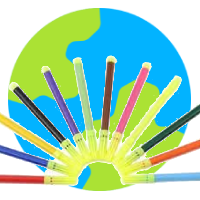Sketch pens, often called marker pens, are universal tools that have revolutionized how we approach writing, art, and design. Their story is one of transformation—from practical marking instruments to indispensable tools for self-expression and creativity. These vibrant pens have bridged generations, finding a place in the hands of children sketching their first doodles, students crafting vivid presentations, and professional artists creating masterpieces.
But how did a simple felt-tip invention grow into a cultural phenomenon? Let’s explore the history of this colorful writing tool as we delve into its background.
The Origins of Sketch Pens
A Detailed Timeline of the History of Sketch Pens
1910
The Birth of the Felt-Tip Pen

Lee Newman patented the first felt-tip marking pen in 1910. This rudimentary tool consisted of a reservoir of ink housed within a casing and delivered through a felt tip. It was primarily designed for labeling and marking, offering a more efficient alternative to brushes and quills for certain tasks.
1926
The Precursor to the Marker Pen

In Europe, Benjamin Paskach introduced a fountain paintbrush with a felt tip. While not a true marker or sketch pen, this innovation hinted at the direction felt-tip tools would take. It featured a liquid reservoir, much like today’s markers, but was primarily used for industrial applications.
1953
Sidney Rosenthal and the “Magic Marker”

The modern era of sketch pens began with Sidney Rosenthal’s invention of the Magic Marker in 1953. This felt-tip pen had a broader appeal and was marketed as a versatile tool for writing, drawing, and labeling.
1962
Water-Based Markers by Pentel

Pentel, a Japanese company, revolutionized the industry in the early 1960s by introducing water-based markers. These were safer, more vibrant, and easier to use than their predecessors.
1970s
The Sketch Pen Goes Global

By the 1970s, sketch pens had become a worldwide phenomenon. Manufacturers began offering various colors and tip sizes, catering to children, students, and professional artists. During this time, brands like Stabilo and Crayola entered the market, popularizing sketch pens as tools for creative expression.
1980s-1990s
Rise of the Professional Marker Pens

By the late 20th century, sketch pens had become a cult favorite. Children loved them for their vibrant colors and ease of use. Artists embraced them for their precision and versatility. Sketch pens made art accessible, whether for casual doodles or intricate designs. Professional-grade markers like Copic (introduced in 1987) and Sharpie (introduced in 1964 but gaining prominence in this era) redefined sketch pens.
2000s
Digital Meets Traditional

The early 2000s saw the emergence of digital sketch pens, which combined traditional artistry with technological advancements. Tools like Wacom’s digital pens mimicked the functionality of physical sketch pens, offering artists a bridge between physical and digital media.
The Impact of Modern-Day Sketch Pens
Today, sketch pens have cemented their place as indispensable tools across various fields. Their evolution—from simple markers to versatile instruments of expression—reflects a perfect synergy of innovation and creativity.

Education and Child Development
Sketch pens are a staple in classrooms and homes, helping children explore their imagination. They are widely used in schools for arts and crafts, diagrams, and projects, nurturing creativity and motor skills. The vibrant colors and ease of handling make them ideal for young learners, promoting engagement and self-expression.

Art and Design
In the art world, sketch pens are cherished for their versatility. Professional illustrators, graphic designers, and architects use high-quality markers like Copics and Sharpies for precise line work, shading, and rendering. Their adaptability extends to mixed media, where they seamlessly integrate with watercolors, pastels, and digital tools.

Home and DIY Projects
From personalizing greeting cards to decorating walls with hand-drawn murals, sketch pens are a favorite for DIY enthusiasts. They simplify complex projects with their precision and allow hobbyists to experiment with diverse techniques, from calligraphy to intricate pattern work.

Corporate and Professional Use
In offices, sketch pens are indispensable for brainstorming sessions, presentations, and planning. Their bold colors make them perfect for whiteboards and flip charts, helping teams visualize concepts effectively. Creative industries like advertising and animation also rely heavily on sketch pens for storyboarding and conceptual design.

Industrial and Technical Applications
Beyond artistic endeavors, sketch pens serve functional purposes in technical and industrial fields. Engineers and drafters use them for blueprints, technical drawings, and annotations. In laboratories and factories, they are used for labeling and marking on specialized surfaces.

Pop Culture and Fashion
Sketch pens have become pop culture tools, influencing graffiti, street art, and fashion trends. Designers use them to prototype patterns and embellishments, often blending traditional techniques with modern aesthetics.
Sketch Pens: A Timeless Creative Companion
Over a century since their introduction, sketch pens inspire generations and professionals alike. Their ease of use, portability, and ever-expanding range of colors make them essential tools for creativity. Whether in the hands of a child working on a school project, an artist creating a masterpiece, or a professional refining their vision, sketch pens serve as a timeless testament to the power of imagination. Their legacy goes beyond innovation; they enable people to bring their ideas to life in vibrant and dynamic ways.
Why Choose Spartex Sketch Pens
Spartex embodies the ideal fusion of tradition and innovation, delivering vibrant colors, exceptional precision, and lasting quality. Whether fostering a child’s creativity, creating captivating artwork, or enhancing professional projects, Spartex Sketch Pens are meticulously crafted to elevate every creative endeavor.
Get in touch with us for an instant quote!
Request Quote
